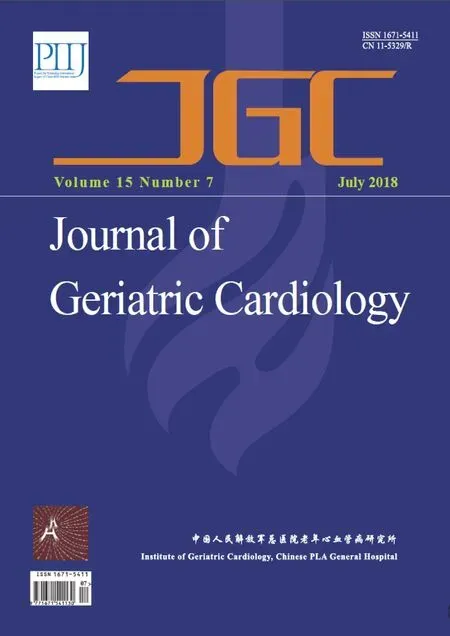Acute lymphocytic myocarditis
Maedeh Ganji, Jose Ruiz-Morales, Saif Ibrahim
?
Acute lymphocytic myocarditis
Maedeh Ganji1, Jose Ruiz-Morales2,*, Saif Ibrahim3
1Cardiology Department, University of Florida, Jacksonville, FL, USA2Internal Medicine Department, University of Florida, Jacksonville, FL, USA3Interventional Cardiology Department, University of Alabama-Birmingham, Birmingham, AL, USA
J Geriatr Cardiol 2018; 15: 517?518. doi:10.11909/j.issn.1671-5411.2018.07.009
Cardiomyopathy; Myocarditis; Heart attack; STEMI; Sudden cardiac death
Myocarditis is an inflammatory disease of the my-o-cardium. The clinical presentation of myocarditis may range from subclinical to sudden death. The incidence of fatal myocarditis, which often presents with sudden or rapid death, has been estimated at 0.15/100.000 in the general population and is highest in infants and young adults (but may affect any age group). However, diffuse myocarditis in autopsies of sudden death is < 2% in adult. Myocarditis usually presents with heart failure symptoms over a few days to weeks. The classic presentation of viral myocarditis includes a viral prodrome with fever, myalgia, and upper respiratory symptoms. Patients present with dyspnea, chest pain, and arrhythmias. ECG abnormalities are often present, along with evidence of myocardial damage with elevated troponin levels. We present the case of a 78-year old white male who died from acute cardiac decompensation from diffuse acute lymphocytic myocarditis.
A 78-year old white male with a medical history of hy-pertension and asbestosis who presented to the emer-gency department with agitation and wide complex tachycardia after three nights of difficulty sleeping, shortness of breath and diaphoresis. Patient required emergent intubation for hypoxic respiratory failure. An ECG performed at the time of admission was read as possible ST-segment elevation myocardial infarction (STEMI) and the patient was taken to the cardiac catheterization lab. The procedure found open and patent coronary vasculature within the exception of occlusion of a branch of the second obtuse marginal artery branching from the left circumflex artery which was treated with a Plain Old Balloon Angioplasty (POBA). During the same day, patient went into cardiac arrest and deceased.
An autopsy, the major pathological findings that explain the patient’s terminal course were in the heart which was affected by extensive diffuse myocarditis, predominantly lymphocytic with associated myocyte necrosis and dilated cardiomyopathy. The inflammation is more marked in the left than the right ventricle and is also involving the papil-lary muscles, endocardium and focally the epicardium. Scarring with dystrophic calcification in addition to the in-flammation is present at the atrioventricular-septal junc-tion (Atrioventricular node site). Inflammation is also focally present at the junction of right atrium and superior vena cava (Sinoatrial node site). Myocardial scar tissue from remote infarction or chronic ischemia is present in the inner lateral wall of the left ventricle.
Other findings in the cardiovascular system include moderate calcific arteriosclerosis of aorta and aortic valve with mild coronary arteriosclerosis. The coronary arteries thrombosis reported in the provisional gross anatomic evaluation was actually blood clots dissolved during proc-essing for histological examination. Irrelevant to the pa-tient’s demise, include dense hyaline plaques in the pleura, diaphragm, ribcage with focal adherence to the lung and subpleural fibrosis consistent with the patient’s clinical his--tory asbestosis. No evidence of mesothelioma is pre-sent. Congested viscera, diverticulosis and small cortical infarct (1cm) in right kidney are present.
Myocarditis may be idiopathic or caused by viral, bacte--rial or fungal infections, immune disturbances (autoimmu--nity or hypersensitivity) or a combination of infections trig--ger by secondary autoimmunity. The identification of un--derlying organism is not usually possible or effective be--cause organisms, particularly the virus, is often cleared by the immune system before significant inflammation occurs.
Clinical subsets of myocarditis include: (1) fulminant myo-carditis associated with fever; (2) acute myocarditis without fever, self-limited or associated with acute onset heart fail-ure; (3) chronic active myocarditis characterized by de-velopment of fibrosis and giant cells; (4) chronic persis--tent myocarditis characterized by persistent myocyte necro--sis.
The differential diagnosis of the underlying cause of myo-carditis can be categorized according to the predomi-nant pattern in the inflammation as follows: (1) lymphocytic myocarditis (as in this case) is the most common form of myocarditis and is associated with viral/postviral infection, autoimmune/connective tissue disease or idiopathic; (2) neutrophils rich and microabscesses are mostly bacterial or fungal myocarditis; (3) eosinophils predominant myo--cardi-tis is more consistent with underlying allergy/hyper-sen---sitivity to drugs, parasitic, hypereosinophilic syndrome or sometimes idiopathic; (4) giant cells and granulomatous myocarditis are most likely from auto-immunity, mycobac---terial or fungal infection or sarcoidosis; (5) paucity of in---flammatory cells occurs in toxic myocarditis/catecholamine induced myocardial injury.
In this case, the predominance of lymphocytic infiltrate in myocarditis without neutrophil microabscesses, promi--nent eosinophils, giant cells or granuloma is most consistent with the differential etiology of viral/postviral infection, autoi-mmune/connective tissue disease or idiopathic.
1 Fabre A, Sheppard MN. Sudden adult death syndrome and other non-ischaemic causes of sudden cardiac death. Heart 2006; 92: 316–320.
21998971802
19941562
joseruiz_21@hotmail.com
 Journal of Geriatric Cardiology2018年7期
Journal of Geriatric Cardiology2018年7期
- Journal of Geriatric Cardiology的其它文章
- Single-territory incomplete surgical revascularization improves regional wall motion of remote ventricular areas: results from a propensity-matched study
- A three-year longitudinal study of the relation between left atrial diameter remodeling and atrial fibrillation ablation outcome
- Particular evolution in a 72-year-old diabetic patient with acute coronary syndrome
- Management of hypertensive crises in the elderly
- C-reactive protein aggravates myocardial ischemia/reperfusion injury through activation of extracellular-signal-regulated kinase 1/2
- Prognostic utility of NT-proBNP greater than 70,000 pg/mL in patients with end stage renal disease
